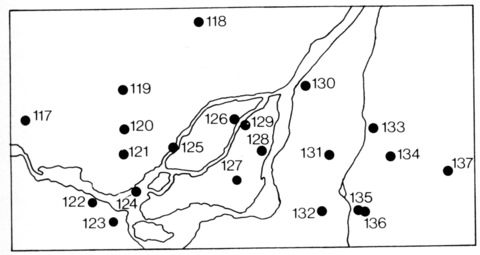stripes
Outcrops of what may be a single sill (Clark, 1952, p. 96) are found at many localities on Ile Jesus the most extensive being just north of Sainte-Dorothee. The sill is 5.7 m thick at Ste- Dorothee with upper and lower chilled contacts, and intrudes Lower Ordovician Beekmantown dolomite. The rock is a fourchite with 1- 3% phenocrysts of mauve titanaugite and zoned brown to green hastingsite, in a groundmass of hastingsite, titanaugite, opaque oxides, analcime, plagioclase (An41-15) alkali feldspar and apatite. There are layers in the lower part of the sill in which phenocrysts run to 20%, together with numerous analcime veinlets. In the upper part of the sill is a zone rich in small xenoliths of igneous and sedimentary rocks, together with ocelli up to 10 cm in diameter, which constitute 10-15% of the rock. The ocelli consist of plagioclase (An35-18), brown amphibole, sanidine, analcime and carbonate and have been interpreted as being due to liquid immiscibility (Philpotts and Hodgson, 1968; Philpotts, 1976). Eby (1980), using specimens described by Philpotts (1976), has investigated the minor and trace element partitioning between ocelli and matrix. Three hills of breccia northwest of Ste-Dorothee, although somewhat altered, are considered by Gold and Marchand (1969, p. 30) to be alnoitic.
CLARK, T.H. 1952. Montreal area Laval and Lachine map-areas. Geological Report, Quebec Department of Mines, 46: 1-159.
Eby, 1980; GOLD, D.P. and MARCHAND, M. 1969. The diatreme breccia pipes and dykes, and the related alnoite, kimberlite and carbonatite intrusions occurring in the Montreal and Oka areas, P.Q. Part 1: The alnoite, kimberlite, and diatreme breccia pipes and dykes. In Geology of the Monteregian Hills (Ed. G. Pouliot). Geological Association of Canada - Mineralogical Association of Canada, Guidebook: 5-42.
PHILPOTTS, A.R. 1976. Silicate liquid immiscibility: its probable extent and petrogenetic significance. American Journal of Science, 276: 1147-77.
PHILPOTTS, A.R. and HODGSON, C.J. 1968. Role of liquid immiscibility in alkaline rock genesis. International Geological Congress, Report of 23rd Session, Czechoslovakia, 2: 175-88.

